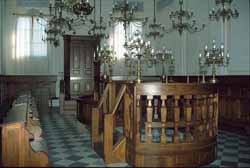The community grew as more Jewish exiles arrived from Florence, and the synagogue was constructed in 1598. A school was built during this period and a plot of land was allotted for a Jewish cemetery. The Jewish newcomers quickly went into business as carpenters, weavers, shoemakers, tailors, bookbinders and moneylenders. When Pitigliano became part of the Grand Duchy of Tuscany in 1608, Jewish prosperity and freedom were threatened when the Medici family replaced the Orsini family. Privileges the Jews had enjoyed under the Orsini family were rescinded. They no longer could own their own land. Discussions took place on whether the Jews would have to move to the ghettos in Florence or Siena, but, instead, a ghetto was built set up in 1622 in a small area around the synagogue. The Jews could no longer live anywhere or practice any trade they pleased. Similar to other Jews in Tuscany, Jews were forced to wear specific items of clothing that marked them as a Jew, a red hat for men and a red badge worn on the shirt sleeves for women. Jews, occasionally, had to pay special taxes for various projects, such as the building of a guard house and a fountain. Despite the restrictions, the Jewish community continued to flourish and prosper. In the mid-18th century under the House of Lorraine, living conditions improved. In 1773, Pitigliano had a Jewish population of 200. Jews were involved in all sorts of trades and owned shops selling crafts, cloth and spices. Napoleon’s conquest of Italy in 1799 dramatically changed the situation of the Jews of Pitigliano. The Jews sided with the French for both philosophical and pragmatic reasons; the revolutionary motto “liberté, egalité, fraternité” translated into at least temporary freedom from ghettos in many towns. So when the anti-French fervor of much of the rest of the population erupted, violence was directed at the Jews. Jews felt the repercussions of the Viva Maria riots in Arezzo, when houses in the ghetto were ransacked and fourteen members of the community were arrested. Riots in Monte San Savino destroyed its Jewish community. In Siena, the synagogue was burned and 13 Jews were brutally murdered. The Jews of Pitigliano suffered a progrom in which a band of ruffians from a nearby town defaced the synagogue. Soon after this incident, life returned to normal for the Jews of Pitigliano. The early 19th century is remembered as “the golden age” of Little Jerusalem. In 1825, Jews owned 94 houses, 20 warehouses, 11 shops and 10 stables in the town. In 1833, a school and a charity organization were started. Friction arose between the Jewish and Christian communities over the issue of forced conversions of Jewish children. Despite the friction, the Jewish population grew and reached 359 by 1841. At this time, the Jewish community had one rabbi, two vice rabbis and several teachers. Between 1850 and 1861, the Jewish population reached four hundred, about twenty percent of the general population. In 1859, the 423 Jews of Pitigliano were emancipated and were granted equal rights. Businesses flourished; there was a school, and institution to care for the poor, and in 1865, a huge library was built, which housed more than 600 books written in Hebrew. After the unification of Italy in 1861, Pitiglianese Jews began emigrating to nearby Livorno and other cities, largely for economic reasons. This marked the beginning of the decline of the Jewish population of Pitigliano. Many Jews decided to leave Pitigliano and move to larger cities in Tuscany, while others converted to Christianity. But a core community remained and continued to contribute to local life. By 1931, the Jewish population had declined to 70. A massive anti-Semitic campaign began in 1936. Racial laws were instituted in 1938, and by this time, there were only 60 Jews left in Pitigliano. More Jews left Pitigliano and immigrated, while others were deported. When the Nazis came, those who remained hid with farming families in the surrounding hills and valleys. After the war, only 30 Jews came back to Pitigliano. The synagogue had been damaged when the Allies bombed the Meleta River bridge to strop retreating Germans. Today, only three members of the Jewish community are left; nevertheless, the Jewish cultural heritage has been preserved. The synagogue was restored, a project that began in 1980 with the help of the Jewish communtiy of Livorno and was completed in 1995. Cultural events take place there; a kosher bakery was also reopened. A kosher version of Pitigliano’s famous wine is also being manufactured, labeled La Piccola Gerusalemme. The synagogue was built in 1598 and restored numerous times. It collapsed in 1970 and was restored again in 1995. It is located in the area of the former ghetto. The cemetery was used for the first time in the 16th century, when David de’ Pomis, a doctor, buried his wife there. It is located on the outskirts of the town, on the road to Marciano. Sources: Jewish
Culture of Pitigliano. |
